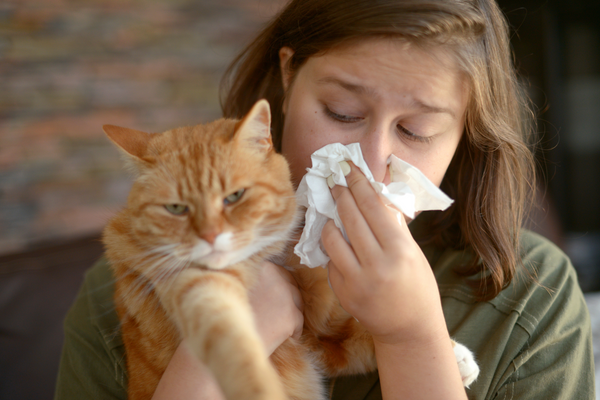Signs Your Dog Could Be Suffering From Allergies (And Ways to Help)

Just like in humans, seasonal and environmental allergies can cause discomfort for our canine companions. Unfortunately, identifying these symptoms as allergies isn’t always easy. Since your beloved four-legged friend can’t exactly tell you what’s wrong, it’s up to you to look for the signs. Read on to learn about common dog allergens, allergy symptoms, and tips on how to help your dog if they have an allergic reaction.
Which Dog Breeds Are Most Prone to Allergies?
Certain dog breeds are more predisposed to allergies than other breeds. However, any dog of any breed (including mixed breeds) can have allergies. Generally, most allergic dogs begin to show signs between six months and three years of age. Some dog breeds that are more prone to allergies include:
- Golden Retrievers
- Labrador Retrievers
- West Highland White Terriers
- Wirehaired Fox Terriers
- Boston Terriers
- Scottish Terriers
- English Bulldogs
- French Bulldogs
- Chinese Shar-Peis
- Lhasa Apsos
- Shih Tzus
Types of Allergies in Dogs
A dog’s allergy symptoms are generally similar to those experienced by humans: the immune system overreacts to one or more offending substances, leading to a long list of negative symptoms. This can be more than uncomfortable for dogs and heartbreaking for pet parents to watch; your dog may excessively lick or scratch themselves, develop chronic ear infections, or sneeze repeatedly. Some dogs experience itchy, red skin, while others suffer from vomiting and diarrhea. In some cases, a secondary infection may develop. And, just like in people, there are quite a few different types of allergies in dogs. Skin allergies, food allergies, and environmental allergens all pose challenges for dogs and their owners. To make things more complicated, the symptoms of all these different types of allergies can overlap.
Skin Allergies (Allergic Dermatitis)
When a dog’s allergic reaction is skin-related, it’s called allergic dermatitis. This is the most common type of allergic reaction in dogs. Skin allergies are more than a nuisance as they can also pose the risk of secondary infection. As your dog incessantly scratches, chews, and licks their skin, they risk opening up their skin to yeast and bacterial infections that may require treatment.
There are three leading causes of skin allergies in dogs:
Environmental Allergens
Environmental allergens, like dust mites, dander, molds, pollen, cleaning products, fragranced products, and harsh pet shampoos can cause atopic allergic reactions or atopic dermatitis in dogs. The most commonly affected areas are the ears and paws, but can also include the wrists, muzzle, underarms, groin, around the eyes, and in between the toes.
Related: Dust Mite Allergies in Dogs: How to Reduce Allergens & Give Your Dog Relief
Flea Allergy Dermatitis (FAD)
When allergic dermatitis is caused by an allergy to fleas, it’s called flea allergy dermatitis (FAD). When a flea bites a dog, it injects saliva under the dog’s skin. Flea bites will cause any dog to feel itchy and uncomfortable, but many dogs are hypersensitive to the flea saliva and have an allergic reaction when bitten. FAD may cause a longer, more intense reaction (up to 2 weeks after a bite) than typical itching associated with flea bites. Additionally, the dog’s skin may become red and inflamed. You may also notice signs of fleas, such as flea dirt, or even see the fleas themselves.
Food Allergies
Although food allergies in dogs are less common than environmental allergies, they can be challenging for pet owners. For dogs diagnosed with food allergies, finding a diet that’s free from offending ingredients is life-changing for the dog. While any individual dog can be allergic to almost any food ingredient or ingredients, many veterinarians point to animal proteins as the most common culprits. A 2016 study on common food allergen sources in dogs and cats identified that dogs’ most common triggers for food allergies include beef, dairy products, chicken, and wheat. Symptoms of food allergies in dogs can range from skin conditions (itchiness, facial swelling, hives, etc.) to gastrointestinal signs (vomiting and diarrhea) or a combination of both. A severe reaction resulting in anaphylaxis can occur in rare cases, similar to severe peanut allergies in humans.
Symptoms of Allergies in Dogs
Like humans, the symptoms and severity of allergies in dogs may vary depending on the cause and the individual’s susceptibility to the allergic reaction. For instance, a dog that goes into anaphylactic shock will have a drop in blood pressure followed by shock, which is very different from a mild skin condition. If your dog has a severe allergic reaction, your best course of action is to get them to an emergency veterinary hospital as quickly as possible.
Generally, the following symptoms could be a sign of an allergic reaction in dogs:
- Itchiness
- Excessive licking, scratching, and/or chewing at particular areas of the body
- Open sores, scabbing, and hair loss
- Swelling of the face, lips, ears, eyelids, or ear flaps
- Runny nose
- Red, inflamed skin
- Sneezing
- Vomiting
- Diarrhea
- Hives
- Chronic ear infections
- Itchy, watery eyes
It’s important to note that these symptoms could also be a sign of another condition. If your dog shows signs of any adverse symptoms, consult with your veterinarian to get an accurate diagnosis and help your dog start feeling better.
Diagnosing Allergies in Dogs
Dog allergies are incredibly common, but they can take some detective work to identify and treat. First, your veterinarian will likely rule out any other condition that could be causing your dog’s symptoms by conducting a thorough examination and tests. If your veterinarian feels that an allergy is a likely culprit, they may propose allergy testing to determine the allergen causing the reaction.
Environmental allergies, while very common, can be challenging to pinpoint. Your veterinarian may perform skin or blood testing to determine the culprit. Generally, these types of tests are only performed by board-certified veterinary dermatologists.
Typically, flea allergy dermatitis is the simplest allergy to diagnose. Your veterinarian will identify the presence of fleas on your dog’s body and apply a product that kills fleas before they can bite to see if that solves the issue.
If your veterinarian suspects food allergies, they’ll likely recommend an elimination diet to determine the specific ingredient your dog should avoid. Usually, a food trial consists of feeding a dog a single source of protein and carbohydrates for 12 weeks.
Tips to Reduce Dog Allergies
Your veterinarian can usually best guide you on diagnosing and treating your dog’s allergies. Depending on the seriousness of the problem, a veterinarian can provide more aggressive treatments such as antihistamines, steroids, or allergy shots, also known as immunotherapy. However, pet owners can take steps at home to reduce allergens and help their dogs feel better. Once you’ve determined what exactly your dog is allergic to, it’s essential to avoid those substances when possible. Here are a few things you can do to help keep your dog’s allergy symptoms and discomfort under control:
Bathe Your Dog Regularly

While humans are more likely to have their allergy symptoms triggered through inhalation, dogs usually absorb allergens through their skin or paws. For this reason, regular bathing can help prevent allergy triggers from allergens that can be caught in the fur. The Ecology Works Anti-Allergen Pet Shampoo helps dogs overcome skin problems caused by dust mite allergens and dander while also cleaning and conditioning for a soft and healthy coat. Our pet shampoo also helps eliminate fleas and ticks.
P.S. You can also combine the Anti-Allergen Pet Shampoo with The Ecology Works Dust Mite & Flea Control for a dual effect and complete allergen control. Check out The Ecology Works’ Pet Lover’s Special here.
Adapt Your Daily Walk Routine
If your dog has a pollen allergy, try to avoid walking them in the early morning and late afternoon, when pollen levels are typically highest. Also, try to steer clear of parks and open fields where offending plants are usually abundant. If you do walk on a day when pollen levels are high, bathe your dog with the Anti-Allergen Pet Shampoo when you return home.
Frequently Wash Your Dog’s Bedding & Toys

Once a week, or more often if your dog has severe environmental allergies, wash your dog’s bed, blankets, and stuffed toys with The Ecology Works Anti-Allergen Laundry Detergent to remove allergens from dust mites, dander, and molds. Our hypoallergenic laundry detergent is recommended by allergists and dermatologists and is also highly effective against stains, odors, and grime.
In between washes, thoroughly vacuum your dog’s bed and spray it with The Ecology Works Anti-Allergen Solution to neutralize common household allergens.
Avoid Chemical Triggers in Products
Besides environmental allergens like dust mites and molds, dogs can also be allergic to chemicals found in household cleaning products. And even if they aren’t allergic, chemicals like bleach, ammonia, and fragranced cleaners can be incredibly irritating to dogs. To avoid these chemicals, the best way to start is by reducing the exposure in your home.
Our all-in-one cleaner, stain remover, and disinfectant, Vital Oxide, is free from bleach, ammonia and VOC's. Vital Oxide is perfect for cleaning every area of the home and is powerfully effective against pet messes. Bonus: Vital Oxide cleans away allergens and odors!
Related: Have Pets? Consider Ditching These Chemicals
Frequently Vacuum Carpet, Rugs, & Upholstery

Use a HEPA vacuum to vacuum soft surfaces like carpet, rugs, and upholstery thoroughly to capture dust, pet dander, and other airborne allergens at least once a week. After vacuuming, spray surfaces with our Anti-Allergen Solution to eliminate the allergic effects of pet dander and dust mites. Its gentle formula will not damage the surfaces or articles treated.
Have questions about reducing common indoor allergens? We have answers! The Ecology Works has been helping people and pets with allergies since 1993. We can help you select the products you need to live a better, allergen-free life. Please feel free to Contact Us or message us on Facebook. No question is too small! We’re here to help.




